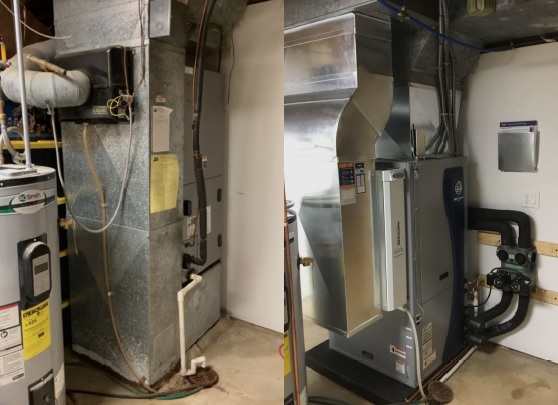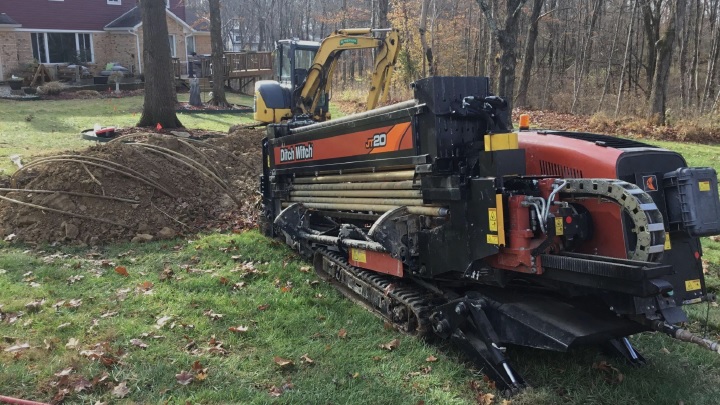Is Geothermal HVAC Right For Your Home?
Learn The Benefits Of Geothermal Heating & Cooling with Watkins
Overview of Geothermal Heat Pumps
Geothermal heat pumps are a type of heating and cooling system that use the earth's natural temperature to regulate the temperature inside your home. They work by extracting heat from the ground in the winter and transferring it into your home, and removing heat from your home in the summer and transferring it back into the ground. Unlike outdoor air temperature which varies widely from season to season, the underground soil temperature in Dayton Ohio stays about 52°F year round. This results in a more efficient and sustainable heating and cooling system.
Geothermal is Perfect for Ohio's Climate
Ohio experiences harsh winter temperatures, making heating a crucial aspect of home comfort. At the same time, Ohio residents are seeking more environmentally-friendly and cost-efficient solutions for heating and cooling their homes. Air source heat pumps work great for only about 60% of our winter. When the outdoor temperature drops below about 35°F, there’s just not enough heat content in the cold winter air and the heat pump begins to use backup heat such as electricity or gas. Because the ground temperature is constant throughout the winter, geothermal heat pumps produce ample heat through the entire season, making them a perfect choice for Ohio’s climate.
Geothermal vs. Traditional Heating Systems
Compared to traditional heating systems, geothermal heat pumps are easily twice as energy-efficient. They also have a longer lifespan, and they don't require fuel deliveries like propane or oil-based systems. Additionally, the entire system sits in your furnace room with no noisy outdoor air conditioner. As a bonus, your geothermal heat pump can heat your domestic water practically free using the excess from the compressor.

BENEFITS OF A WATERFURNACE GEOTHERMAL HEAT PUMP
Lower Utility Bills
The efficiency of a geothermal heat pump ranges from 22 SEER to almost 40 SEER! At up to 5 COP, the heating is more efficient than a 98% Gas Furnace!
Lower Utility Bills
The efficiency of a geothermal heat pump ranges from 22 SEER to almost 40 SEER! At up to 5 COP, the heating is more efficient than a 98% Gas Furnace!
Lower Utility Bills
The efficiency of a geothermal heat pump ranges from 22 SEER to almost 40 SEER! At up to 5 COP, the heating is more efficient than a 98% Gas Furnace!
Longer Service Life
Protected from the elements and running smoothly on near-constant water temperature, a geothermal heat pump can outlast a standard air-to-air heat pump.
Longer Service Life
Protected from the elements and running smoothly on near-constant water temperature, a geothermal heat pump can outlast a standard air-to-air heat pump.
Longer Service Life
Protected from the elements and running smoothly on near-constant water temperature, a geothermal heat pump can outlast a standard air-to-air heat pump.
Huge Tax Credits
The only thing better than a new geothermal heating system is having the government pay for 30% of the installation! This includes the initial loop cost, the system, and any needed ductwork or electric circuit!
Huge Tax Credits
The only thing better than a new geothermal heating system is having the government pay for 30% of the installation! This includes the initial loop cost, the system, and any needed ductwork or electric circuit!
Huge Tax Credits
The only thing better than a new geothermal heating system is having the government pay for 30% of the installation! This includes the initial loop cost, the system, and any needed ductwork or electric circuit!
Geothermal Installation Process
Types of Geothermal Loops
Retrofitting your home with a geothermal heat pump will involve some type of ground loop to transfer energy between the soil around your home and your living space. There are two types of geothermal loops, closed loops ( horizontal or vertical) and open loops (well water or city water). Closed loop systems circulate a mix of water and methanol through sealed pipes that are in contact with the soil. Open loops draw ground water from a well or city water, extract the heat, then return the water back to the water table through another well. We prefer closed loops because they are more reliable and more cost effective in the long run.
Horizontal loops are one of the most popular types of geothermal heat pump systems due to their affordability. They are installed by digging trenches approximately 4-6 feet deep, with pipes that are placed horizontally in the ground. This system is ideal for properties with a larger amount of land (one acre is plenty), as several hundred feet of trenches are needed to provide efficient heating and cooling for the home. To avoid damage to your lawn, we prefer underground horizontal boring over trenching, though the cost is a little higher. With a well-designed and expertly installed horizontal loop system, homeowners in Ohio can enjoy the benefits of geothermal heating and cooling for years to come.

Vertical loops are a great option for those looking to install a geothermal system on a smaller lot. This type of system is installed by drilling several deep wells in the ground, installing vertical piping, and backfilling the wells with cement. Vertical loops are ideal for properties with limited land, as the holes can be drilled in a smaller area and are less intrusive the horizontal loops. In some cases, vertical loops can offer greater reliability and performance than horizontal loops as the wells are deeper than horizontal loops and the piping is encased in cement.
The right loop design for your home depends on many factors, and that's what we're here for. With the right design and installation, your new geothermal system can raise your property value, save taxes, and provide years of energy-efficient and cost-saving performance.
Trust the Experts
Our team has the expertise and experience to design and install geothermal heat pump systems in the Miami Valley. We have a deep understanding of the specific requirements for Ohio's climate and can provide personalized recommendations for each customer. Our goal is to ensure that every customer is completely satisfied with their geothermal heat pump system.
Book An Appointment Online
Book an appointment
Design and Choose Options
Save Money
Start saving money with Geothermal today:
Book a free design appointment and see if geothermal is right for you!
"Working with Watkins is always a good experience. Scheduling service is simple, and the service techs are knowledgeable and get things right the first time. Thank you for a great job taking care of our family’s HVAC needs." - Ty P. in Springboro

Common Geothermal Questions
Cost of Installation
The cost of installation for a geothermal heat pump can vary, depending on the specific system and the size of the home. Replacement of an existing geothermal system can be as low as $25,000 since the underground piping can be reused for many decades. Retrofitting a standard hvac system requires installation of a ground loop and significant piping and can vary between $30,000 and $50,000 depending on options. However, the long-term cost savings and increased energy efficiency make geothermal heat pumps a smart investment for homeowners, especially after a tax credit of ten to fifteen thousand dollars!
Is It Worth the Money?
Geothermal heat pumps are a long-term investment that can result in substantial cost savings and increased comfort. Geothermal can increase the resale value of your home as the buyer knows their utility bills will be very low. They also have a longer lifespan than traditional heating and cooling systems, making them a smart investment for homeowners.
Tax Credits Available
There are tax credits available for homeowners who install geothermal heat pumps. These credits can help offset the cost of installation and make geothermal heat pumps more affordable. As of 2023, the federal tax credit is 30% of the total installed cost, including ductwork, ground loop, and accessories.
Disadvantages
Geothermal heat pumps have only one real disadvantage. The upfront cost of installation can be higher than other heating and cooling systems. However, the long-term cost savings and increased energy efficiency make geothermal heat pumps a smart investment for homeowners.
Depth of Digging for Geothermal Heat
The depth of digging for geothermal heat depends on the specific system and the site conditions. Horizontal loops are typically buried at four to six feet, while vertical loops are normal 150 feet deep.
Need for Backup Heat
Geothermal heat pumps are designed to provide efficient heating and cooling year-round, but some systems may have a backup heat source for comfort in extreme weather conditions. In most cases, a backup heat source serve as redundancy in case a water pump fails. Either way, the backup heat source is rarely used but nice to have in an emergency.